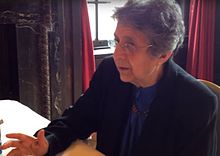Leila Ahmed
Leila Ahmed ( Arabic لیلى أحمد, DMG Lailā Aḥmad ; * 1940 in Cairo ) is an Egyptian-American professor of women's studies. She teaches at Harvard University .
background
As a child of an upper-class Cairo family, Ahmed's childhood was shaped by Muslim-Egyptian values on the one hand, and the liberal orientation of the Egyptian aristocracy of the old regime on the other.
Ahmed received her PhD from the University of Cambridge in the 1960s before moving to the United States, where she was appointed Professor of Women's and Middle Eastern Studies at the University of Massachusetts Amherst in 1981. In 1999 she was appointed professor of women's studies and religion at the Harvard Divinity School.
Works
In her autobiography “A Border Passage”, published in 1999, Ahmed describes her multicultural upbringing and her later life as an immigrant in the West. She tells how she was introduced to Islam by her grandmother in her childhood and learned to distinguish it from the “official” Islam practiced and preached by the mainly male religious elite. This realization later laid the basis for her work "Women and Gender in Islam" from 1992.
In this, Ahmed argues that the oppression of women in the Orient is not due to Islam itself, but to the patriarchal interpretations of Islam. Already in the Koran she differentiates between the ethical message, which states the equality of the sexes, and the concrete stipulations that subordinate women to men, especially with regard to family relationships (polygamy, preference for men in divorce law). She analyzes the gender balance in the Near and Middle East before and during Muhammad's work and comes to the conclusion that most of the societies of that time were already androcentric (and often treated women in a worse position than was the case in the Qur'anic), while Arabia was in Transition from a matrilineal to a patrilineal society was what the above The provisions of the Koran have been accelerated.
In the following period, especially the Abbasid dynasty , who laid the foundation for the further direction of mainstream Islam, the ethical message of gender equality was then completely suppressed in favor of a strong hierarchy with the reduction of women to objects. But she also mentions other currents such as Sufism and Qarmatians , who insisted on gender equality and also practiced it.
In the third part of her book, Ahmed deals with developments especially in Egypt since the 19th century. She goes into the discussion about the veil or headscarf and explains that the colonialists and the western / British-orientated Egyptians equated them with regression, using the feminist discourse of people like Lord Cromer, which was opposed in Great Britain itself women's suffrage occurred. Also Qasim Amin criticized in this context.
While in the 1950s-1970s women from the middle to upper, urban classes oriented themselves more towards the West and rejected the headscarf, for the 1970s-1980s women mainly from the middle to lower, rural classes tended to wear the headscarf firmly. She sees both as strategies for women to achieve more autonomy.
In her latest book, "A Quiet Revolution: The Veil's Resurgence, from the Middle East to America" (2011), Ahmad deals with the widespread reappearance of the headscarf not only in traditional Muslim countries, but also in the western world.
bibliography
- Ahmed: Edward W. Lane: A study of his life and works and of British ideas of the Middle East in the nineteenth century . Longman, London 1978, ISBN 0-582-78083-7 .
- Ahmed: Women and Gender in Islam: Historical Roots of a Modern Debate . Yale University Press, New Haven 1992, ISBN 0-300-05583-8 .
- Ahmed: A Border Passage: From Cairo to America — A Woman's Journey . Farrar Straus & Giroux, New York 1999, ISBN 0-374-11518-4 .
- Ahmed: A Quiet Revolution — The Veil's Resurgence, from the Middle East to America . Yale UP, New Haven 2011, ISBN 0-300-17095-5 .
Web links
- In an interview with Eva Thöne : Attacks in Cologne: "The men knew exactly how to hit the West" , Spiegel Online , January 29, 2016
Individual evidence
- ↑ Fahimeh Farsaie: The Right to Satisfaction In: The Friday of June 10, 2005
- ^ Cultural Fabric. The Long History and Complex Significance of the Muslim Veil in Time July, 11, 2011 page 47
| personal data | |
|---|---|
| SURNAME | Ahmed, Leila |
| ALTERNATIVE NAMES | Aḥmad, Lailā; Aḥmad, Laylá ʻAbd al-Laṭīf |
| BRIEF DESCRIPTION | Egyptian-US university professor and author |
| DATE OF BIRTH | 1940 |
| PLACE OF BIRTH | Cairo |
